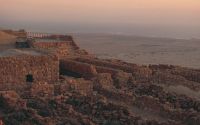19 facts about Masada
The ancient fortress located on the Dead Sea was the site of bloody battles between Jewish insurgents and the Romans.
The Zealots' attitude in defendi ...
32 facts about Jamestown
Although it has not been the first attempt to establish a colony in North America, Jamestown is the first permanent British settlement in the present ...
26 facts about Mohenjo-daro
More than five thousand years ago, in the Indus Valley (now Pakistan), there was a mysterious civilization, called the Indus Civilization. It was one ...



















